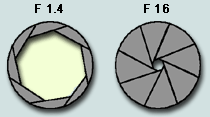|
|
|---|

This block appears when a Camera is selected, and it's where the parameters are set for it. Note: If you have more than one camera in your scene, you can switch the active camera by right-clicking on the "eye" icon of the camera that you want to make active.
Zoom Distance: Sets the zoom of the camera in old CG style values. The higher the number, the more zoomed it will be. This setting is included for people who either don't know real-world focal lengths, or don't care. The number entered here will show up in the Lens Focal Length field as well, so you can see what the true lens setting is. Note: If you right-click on the Key Modifer button (to the right of the channel number) you can activate this control in the World View. In the middle of the camera's representation of the field of view you will see a circle with an L in it. You can drag that back and forth to adjust (and animate) the zoom.
Lens Focal Length: Sets the length (zoom) of the lens. For example a 100mm lens is more telephoto (zoomed) than a 35mm lens. A setting of 50mm when your film size (aperture) is set to 35mm film will give you a "normal" view. In other words, in the real world, when you look through a 50mm lens on a 35mm camera, the image will not be telephoto or wide angle-- the objects that you look at will (or should) be the same size to you whether you are looking through the lens or not. (For 16mm film, it's a 25mm lens.)
Focal Distance: This is the setting for focus. Set the distance to the object you want to focus on in meters. Note: You can do this visually in the Viewport if you want. Just activate the Focal Distance control by right-clicking on the Key Modifier button (to the right of the channel number) so it turns orange, then grab the orange control handle on the Camera's Edit Sphere and drag it out to the item you want to focus on. You will see a square representing the focal plane. If you are not using depth-of-field, you don't need to worry about this setting.
Note: The word "aperture" has two meanings in photography. First is the opening where the film is exposed. This is a square or rectangular hole where the film is pressed up against behind the lens. Second is the aperture that sets how much light will strike the film. This is a round opening made from overlapping slats, and the bigger the opening, the more light gets in. The aperture settings below are the first kind-- the size of the opening where the "film" is exsposed. The aperture setting is important when setting the Lens Focal Length in millimeters and when using the camera's Reticle.
Aperture (pulldown): Select from a list of standard aperture sizes or choose Custom.
Aperture Height (mm): Displays the height of the aperture in millimeters. You can also enter a custom setting here. This setting is tied to the inches version, so you can use either one.
Aperture Height (inches): Displays the height of the aperture in inches. You can also enter a custom setting here. This setting is tied to the millimeter version, so you can use either one.
|
Common Motion Picture Film Negative Sizes |
|||||
| Format |
Ratio |
Width: inches |
Height: inches |
Width: mm |
Height: mm |
| 65mm 5-perf | 2.28:1 | 2.066 | 0.906 | 52.48 | 23.01 |
| 35mm Full Aperture (Default) | 1.33:1 | 0.981 | 0.735 | 24.92 | 18.67 |
| 35mm Anamorphic | 1.18:1 | 0.864 | 0.732 | 21.95 | 18.6 |
| 35mm Academy | 1.37:1 | 0.864 | 0.63 | 21.95 | 16 |
| 35mm 1.66:1 | 1.37:1 | 0.864 | 0.63 | 21.95 | 16 |
| 35mm 1.85:1 | 1.37:1 | 0.864 | 0.469 | 21.95 | 11.912 |
| 35mm 4:3 TV Projected | 1.33:1 | 0.816 | 0.612 | 20.73 | 15.54 |
| 35mm 16:9 TV Projected | 1.78:1 | 0.816 | 0.459 | 20.73 | 11.66 |
| Super 35 for 70mm | 2.2:1 | 0.945 | 0.43 | 24 | 10.92 |
| Super 35 for Anamorphic | 2.4:1 | 0.945 | 0.394 | 24 | 10 |
| Super 35 for 1.85:1 | 1.85:1 | 0.945 | 0.511 | 24 | 12.98 |
| Super 35 for 4:3 TV | 1.33:1 | 0.945 | 0.709 | 24 | 18 |
| Super 35 for 16:9 TV | 1.78:1 | 0.945 | 0.531 | 24 | 13.5 |
| 35mm 3 Perf | 1.58:1 | 0.868 | 0.55 | 22.05 | 13.97 |
| Standard 16 | 1.37:1 | 0.404 | 0.295 | 10.26 | 7.49 |
| Super 16 | 1.66:1 | 0.486 | 0.292 | 12.35 | 7.42 |
Note: The "F-Stop" is the setting for the second type of "aperture" as mentioned in the note above.
F-Stop (pulldown): Select from a list of standard F-Stops. The smaller the number (like 5.6) the less depth-of-field you will have. That is, the smaller the area that will be in focus. The larger the number (like 16), the more depth-of-field you will have. That is, the larger the area that will be in focus. The common F-Stops are: 1.4, 2.8, 4, 5.6, 8, 11, 16 and 22.
F-Stop (1/n): This field displays the current F-Stop and lets you enter a custom value if you want.
